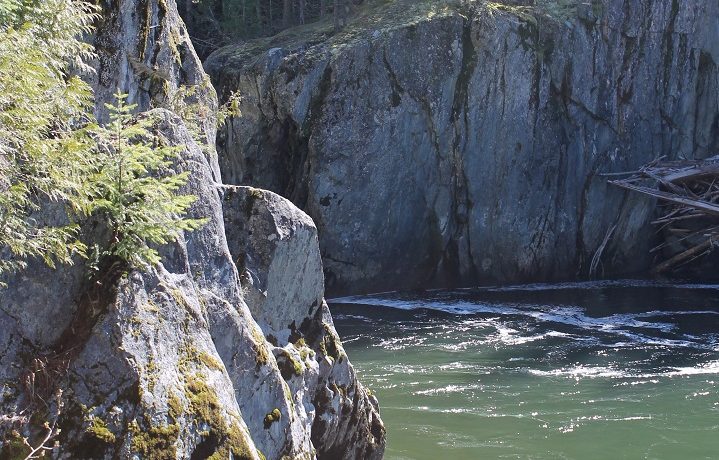It’s not easy to find and it’s been called one of Whistler’s hidden cultural secrets — but for some time, “Train Wreck”, has also been shrouded in a bit of mystery.

Tucked away in an old-growth forest just south of Function Junction in the resort town of Whistler, B.C., ‘Train Wreck’ as it’s known, is a unique juxtaposition between the old and the modern.
The site is equally unique and striking. Among the ancient trees and near the banks of the Cheakamus River are seven CN boxcars that have been urbanized by a riot of colourful graffiti and then surrounded by hiking and mountain bike trails.
The history and mystery of the ‘Train Wreck’
Little was known about the cause of the wreck, which was believed to have happened sometime in the 1950s.
During that era, according to the Whistler Museum, train wrecks were hardly a rare occurrence. When these types of trains were in transit, boxcars often shifted and wobbled to the point where one car would eventually jump the tracks, bringing the remaining cars along with it.
But that was mostly speculation. In the 50s, there was no one living in the area and no local paper established to document the event.
The Whistler wreck puzzled many because the boxcars lie far away from the tracks and yet they are surrounded by old growth trees. There is no trace of a clear path from the tracks to their current location and no evidence of the cars being ripped off the rails and slamming into trees.
- Joffre Lakes to close for 3 periods this year under agreement with First Nations
- ‘Why aren’t we doing more?’ White Rock on edge with killer on the loose
- B.C. carjacking victim says she doesn’t trust the ‘catch-and-release’ system
- Inquest into fatal Surrey hostage-taking recommends cameras for ERT teams
Some who visited the site believed the wreck may have been the result of a slow derailment that happened on a curve along the tracks.
It wasn’t until 2014, in large part due to the Whistler Museum, that the mystery of the train wreck was solved.
Following a 2013 article in the Whistler Question about the mystery of the train wreck by then-executive director of the Whistler Museum Sarah Drewery, she was approached by two people who finally filled in the historical missing pieces.
Rick Valleau told Drewery he remembered his father speaking about the train wreck and his uncle, Howard Valleau, actually recalled the accident firsthand. The Valleau family — who are considered pioneer loggers in the Whistler area, before there ever was a Whistler — owned a logging operation in the former community of Mons, B.C., near the south shore of Green Lake. The Valleau logging operation ran out of Alta Lake (which eventually became Whistler) from 1955 to 1976.
According to the pair, the train wreck happened in 1956, just after the Valleau family settled into the area. The wreck happened in a rock cut after the boxcars, which were loaded with lumber, got jammed and blocked the line.
The train’s owner, Pacific Great Eastern Railway (PGE), which eventually became BC Rail before being sold to CN Rail, did not have the necessary equipment to move the wedged boxcars and turned to the Valleau family for help.
The Valleaus took their logging machinery to the site and managed to pry the boxcars out, dragging them up the track and into the forest, where they lie today. This explains why no trees were damaged around the wreck.
According to Drewery, the conductor of that particular train, John Millar, told Howard Valleau a mistake had been made calculating the tonnage of the train. It ended up being too heavy and eventually the crew split the train to get up a grade near Green Lake. But by taking the time to offset the weight and splitting the train, which had four engines, the crew fell behind schedule.
Following an investigation into the wreck, the engineer and crew were subsequently fired.
Old wreck turns urban
Over time the train wreck site, with the help of local efforts, was transformed into a unique work of art, a noteworthy bike park and a fabulous place to hike.
The first part of the Train Wreck is not the wreckage itself, but instead is several spectacular viewpoints of the Cheakamus River, which can be violent at times, and other times, serene.
The easy hike is about three kilometres long and winds its way along the emerald green river before coming to the stretch of forest that contains seven wrecked box cars strewn over a one-kilometre distance.
Some of the boxcars are perched near the Cheakamus River, while others are squashed against the old trees. But each one is covered, inside and out, by graffiti.
Over the years, well-know graffiti artists like B.C.-born Chili Thom and Whistler street artist Kris Kupskay (along with other graffiti ‘enthusiasts’) have been coming to the site and painting the boxcars. Like growth rings tell the age of trees, the layers of paint on the rusted boxcars show the years of artistic expression.
The sight is both eerie and beautiful.
Thom says he organized a Train Wreck Paint Jam about five years ago, inviting about 40 artists to head out to the site to work on pieces and collaborate.
“I hauled out a generator for music and lights at night,” Thom said.
“[We] ended up with some really great stuff. It’s always been a bit of a practice ground for artists and the setting is absolutely unreal for any graffiti writers who might like tackle the odd train car in the yards. It’s accepted there and the photos you get for your portfolio are unparalleled.”
‘Train Wreck’ becomes officially inaccessible
To get to the “unofficial tourist stop,” people used, in part, the rail lines and in 2014 CN Police began doling out $115 tickets to pedestrians after learning about how many people used the tracks, especially in Function Junction, as a trail.
While the use of train tracks as trails is considered dangerous, it’s also illegal to be trespassing on railway property.
In light of CN’s involvement in 2014, Tourism Whistler ended up removing their online information recommending the Train Wreck site and the trails surrounding it — but information on the trail’s location can still be found on some hiking websites and TripAdvisor.
While the issue has been a concern to Whistler Mayor Nancy Wilhelm-Morden, she says there is a solution in the works.
“We are scheduled this year to build a bridge that will be going over the Cheakamus River to connect the Train Wreck Trail to the Sea-to-Sky Trail, which is part of the Trans-Canada Trail,” Wilhelm-Morden says.
The tender for the project was issued on February 19 and closed on April 4. Wilhelm-Morden says the bids are currently being reviewed and the contract will be awarded by the end of May.
The bill for the new bridge is being picked up by the municipality through their Resort Municipality Initiative (RMI) funding, which they receive from the province every year.
But Train Wreck has never been a municipal trail, so why pay for the expense of a new bridge?
“[Train Wreck] is very unique, it’s one of those authentic experiences. We were hearing from a lot of guests and locals that they were going there,” Wilhelm-Morden says.
“The river itself is absolutely beautiful in that area and the train wreck is pretty cool. When CN talked about ticketing people and policing it, a lot of people expressed to us they were very concerned about it, because it has such appeal. So we thought okay, well it’s an authentic experience, let’s facilitate it by building a bridge.”
PHOTO GALLERY:
The urbanized train wreck that almost wasn’t
In the 1990s the site of the train wreck was almost logged by a company that still held some timber licences, according to Drewery’s 2013 article. But luckily due to a change in logging laws it was forbidden to cut down trees within 15 metres of the Cheakamus River.
After doing some measuring, it turned out that very few of the trees would be eligible to be logged in the area. Regardless, the logging company still wanted to go ahead with their plans but in order for the trees to be taken, and be in accordance with the District Manager at the time, they had to be removed by helicopter and the local community would need to be consulted.
Due to these rules, the logging company held back on their plans and eventually the timber licences were given back to the Crown and the land became part of the Cheakamus Community Forest (CFC).







































Comments